How to create an amazing webinar in 2025
Have you ever thought about hosting a webinar to engage your customers and potential leads? The benefits of a webinar that engages your target group are many - let's dive into how to create an amazing webinar in 2025.
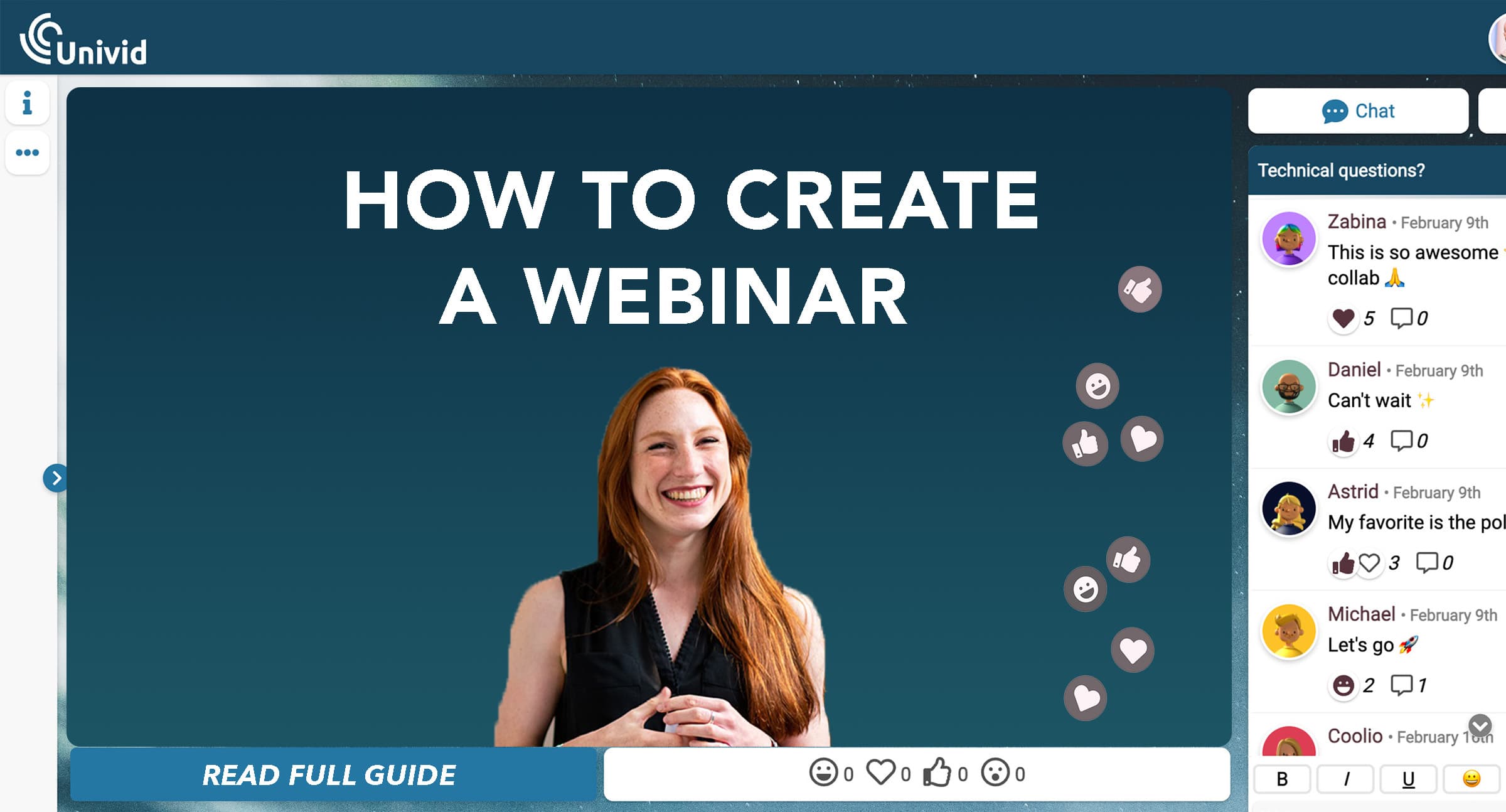
Contents
Summary how to create a webinar to get customers in 2025 [VIDEO]
In the video below, Jonathan walks you through how to set up a webinar that gets your customers for your business.
Or check out the 10 steps in our guide below.
Introduction
Webinars are widely used by companies and organizations for marketing, sales and customer success. Webinars are an excellent choice, whether you are looking for:
more top-of-the-funnel growth
creating brand awareness
establishing thought leadership
push more deals forward in your pipeline
or run more scalable onboardings
Today, there are tons of modern platforms and tools out there, so you can run a webinar using just your webcam and laptop. No downloads or fancy equipment needed.
In this article we go through and answer how to create an amazing webinar in 2025 - following 10 simple steps. Also, we highlight 7 benefits of hosting a webinar.
How to create a webinar
Follow these 10 steps to create and host a really good webinar:
Step 1: Brainstorm topic and format 🧠
Step 2: Invite speakers 🔊
Step 3: Choose time and date 🕤
Step 4: Choose a platform 💻
Step 5: Create the content and plan out interaction 🕹️
Step 6: Invite participants and start marketing ✉️
Step 7: Do a test run 📐
Step 8: Go live and host your webinar 🎥
Step 9: Analyze the data 📊
Step 10: Follow-up and send out on-demand recording 🔴
10 steps to create a successful webinar in 2025
The following steps will take you through how to set up an engaging webinar in 2025, that both draws an audience and converts towards your business goal.
Step 1: Brainstorm - set your topic and webinar format
Focus on your customer, their pain points and challenges - not selling your product.
Be hyper specific to your target group and ideal customer (ICP). Good questions to ask in terms of ICP and topic - what does the ICP need to solve to get promoted in their current role? What KPI:s are the ICP measured on?

Think of your ideal customer and build a concept for this dream attendee
Also, think about what type of webinar you want to host and the outcome you want to achieve. Some questions to ask around the format of your webinar:
Should it be live, automated, or only on-demand?
Does it include guest speakers and/or existing customers?
What length should the webinar be?
Step 2: Invite speakers and panelists
Speakers and presenters are important for attracting audiences and interest. They can help you draw attendees. Sometimes by just highlighting their name, but also if they have an active network they can help you tap into.

Speakers of a webinar - featured on the webinar landing page
Choose carefully here - make sure to use people in your organization, but also be open to bringing in guest speakers and creating a panel of experts.

Step 3: Choose the time and date for your webinar
You want to maximize the amount of signups to get the most out of your webinar efforts. In this guide about webinar registrations - we explain 5 ways to increase webinar registrations. Choosing the right time is definitely one of them.
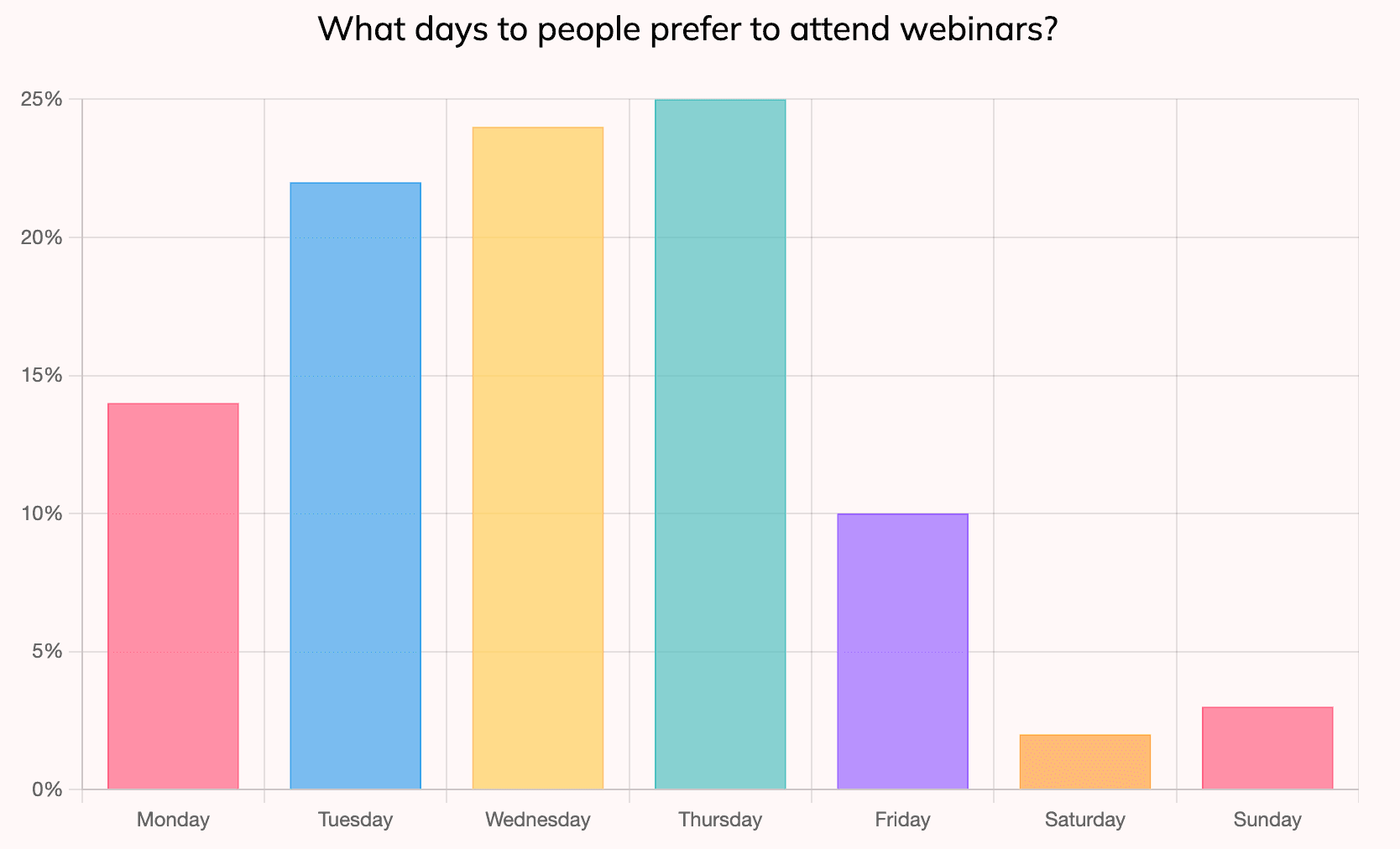
Where does your audience or target audience live? Be sure to keep track of time zones and consider holding multiple webinars on the same topic if you are targeting several different geographic zones.
Check out this free webinar scheduler we built for this exact purpose - to help you schedule webinars on the perfect time.
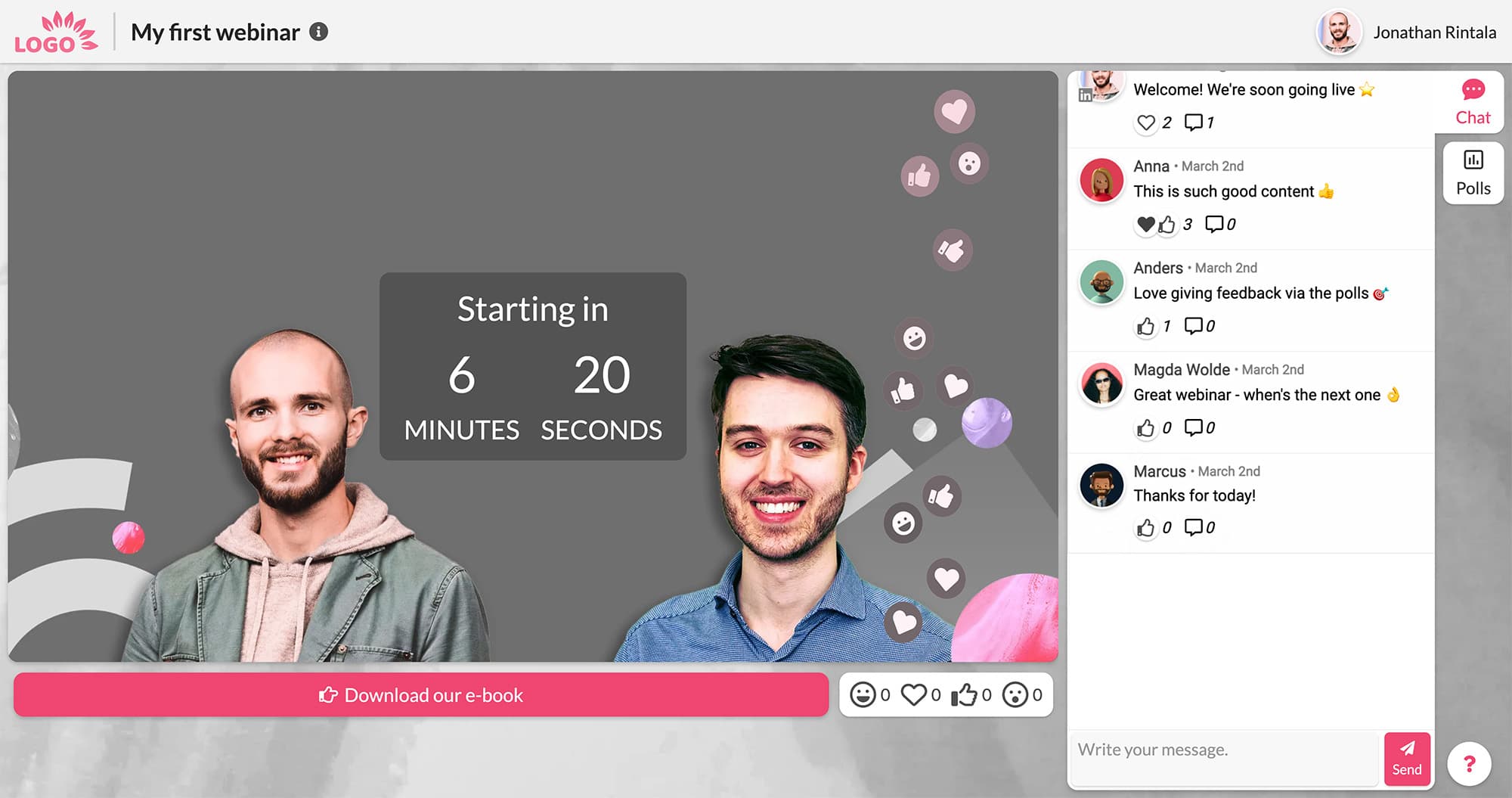
Webinar countdown before going live
Step 4: Choose a platform for your webinar
The first step to creating a webinar is to choose the webinar software. Important factors here are to explore opportunities to:
add a call-to-action button
customize with your own branding
keep the audience engaged
collaborate with team members and guest speakers
what analytics and engagement insights are available afterwards
To understand how to choose webinar software - check out our 6 step guide to choose the best webinar software for your needs.
Step 5: Create the webinar content and plan out interaction
This is where the majority of the work takes place before the webinar. Make sure to prepare what is to be said and presented, but also how the webinar is to be marketed, and how you will engage your audience when live.
The content of a webinar includes a script for what to say - in other words your support notes.
Plan for interactivity and how you will engage the participants - maybe through a few quick activation polls to get to know the audience in the beginning.
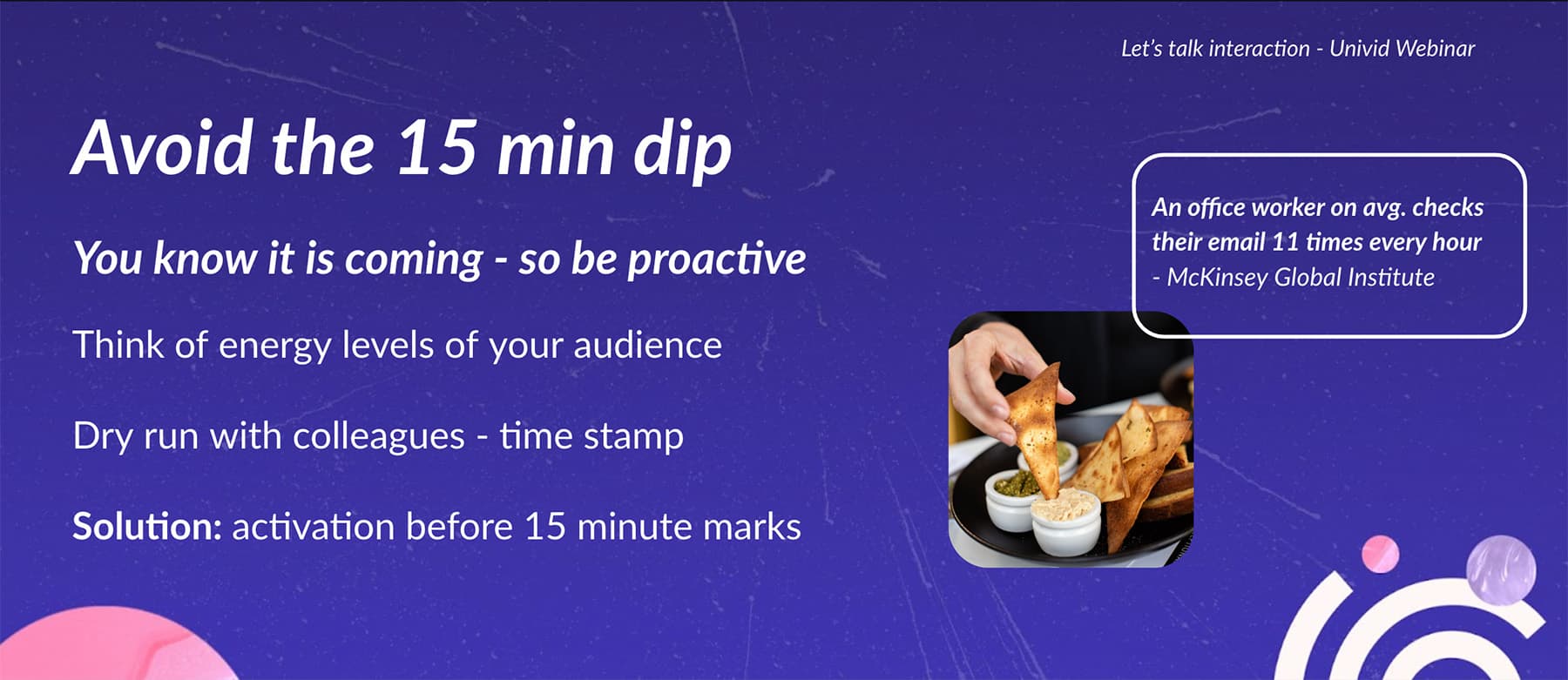
The 15 minute focus dip and how to think about energy levels when creating your webinar
A success factor for engagement: Briefly introducing the Q&A and polls in the start will boost your engagement during the webinar significantly.
Also, don't forget your CTA:s - to drive attendees towards your desired next steps. Having them book a meeting, download e-book, or try your product.
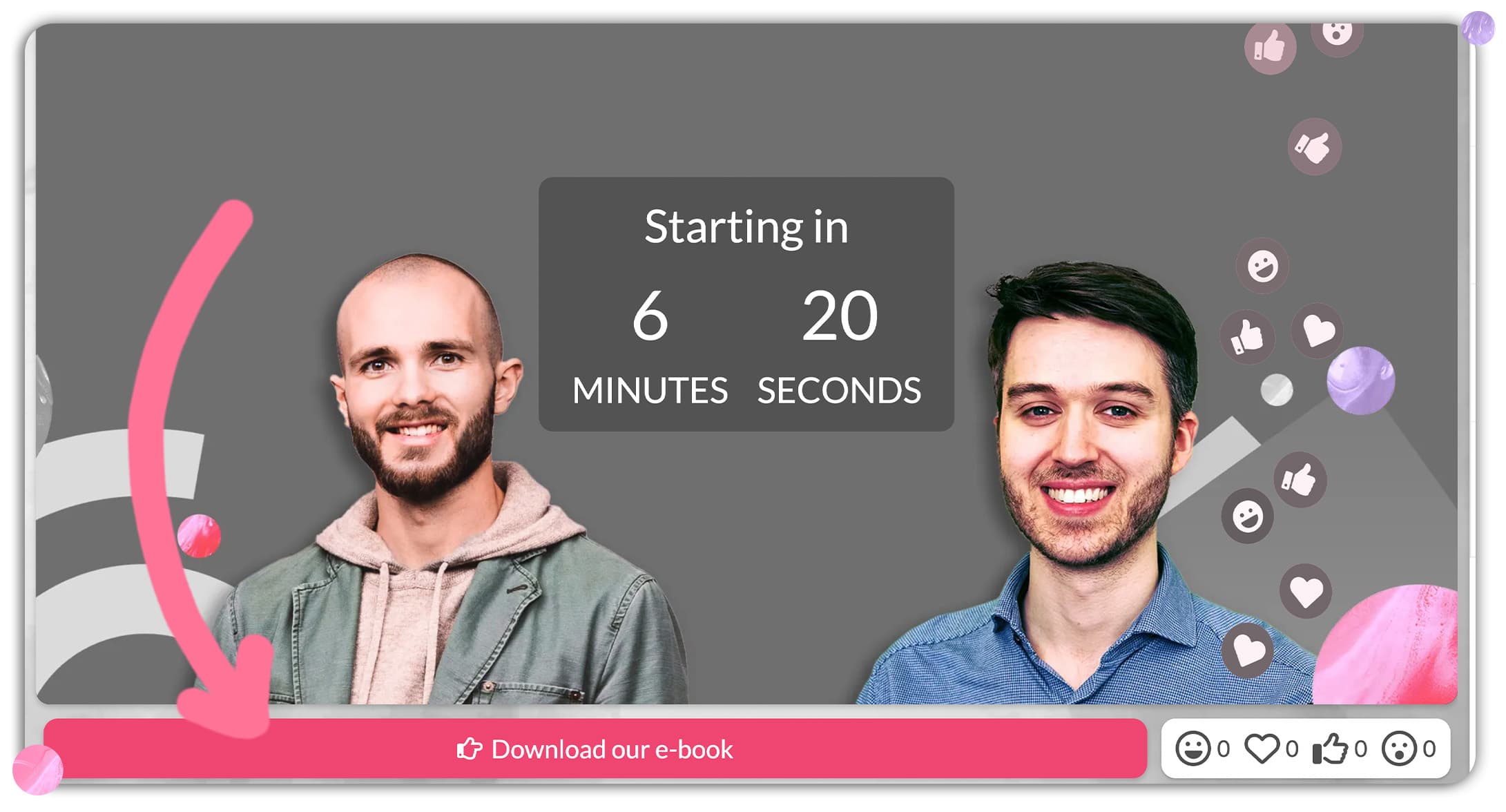
Step 6: Invite participants and start marketing
Be sure to be out well in advance here and market the webinar several weeks before it's time. The majority of participants sign up 1 week before the time, and about 30% sign up the day before the webinar.
Typically attendance rates can be between 40-60%, so make sure to this does not come as a surprise, when you look at your registration list.
Marketing before the event includes creating some form of registration page before the webinar. It's important to include both a confirmation email, once a registrant signed up, but also reminder emails before the webinar. A typical interval could look like:
Webinar reminder # | Time before webinar |
|---|---|
Reminder 1 | 2 days before |
Reminder 2 | 1 hour before |
Reminder 3 | On start |
Ideal reminder email intervals, when hosting a webinar
Typically, a good webinar tool, should have these options automatically configured for you - so you can have branded reminders go out. Also, sending them from a reliable webinar tool - means the emails will get through to your registrants, and not get stuck in email spam filters.
To increase attendance rates - the reminder emails should contain 1. the time and date of the webinar, 2. the title, 3. add to calendar buttons, and 4. a clearly visible 'join webinar' button.
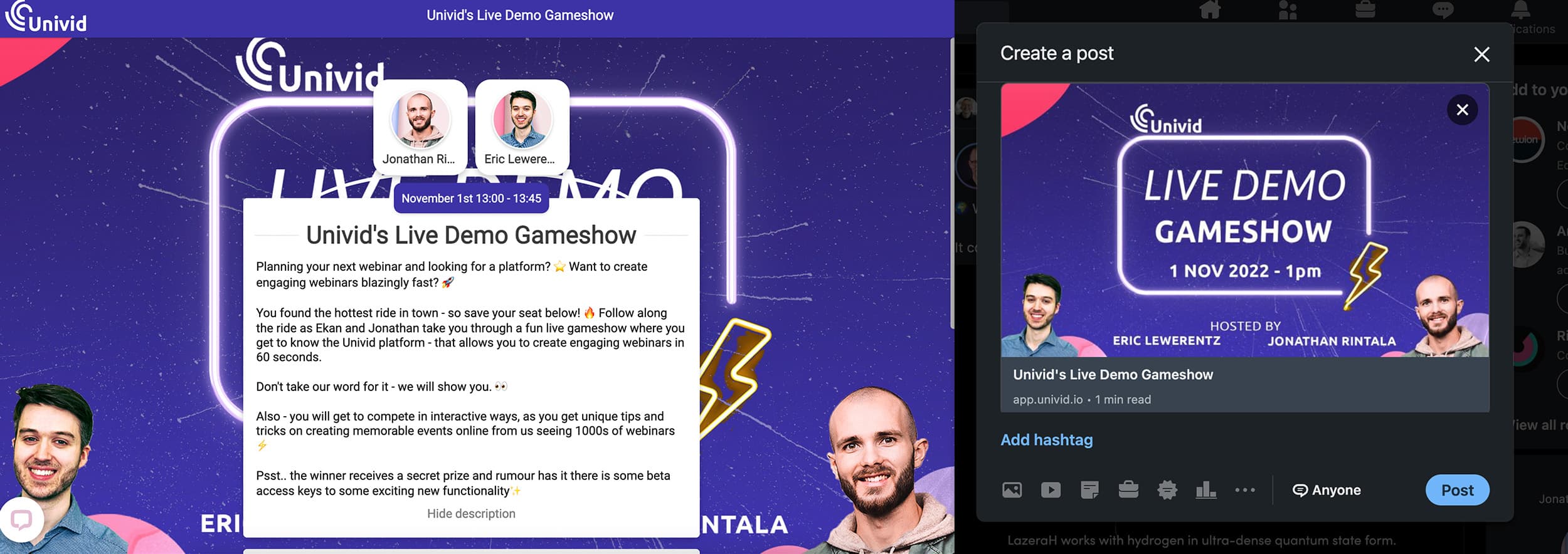
A landing page that can be promoted on LinkedIn and other growth channels
Step 7: Do a test run and get comfortable
Make sure everything is ready for the webinar and that you have tested all the critical steps before going live. Test all tech before, including headphones, internet connection and the webinar software, so that the webinar flows on without interruption or annoying stress.
Step 8: Go live with your webinar
The big day is here and it's time to host your webinar. Make sure to be on time, test all the technology one last time with the other speakers and wait for the time for you to go live.
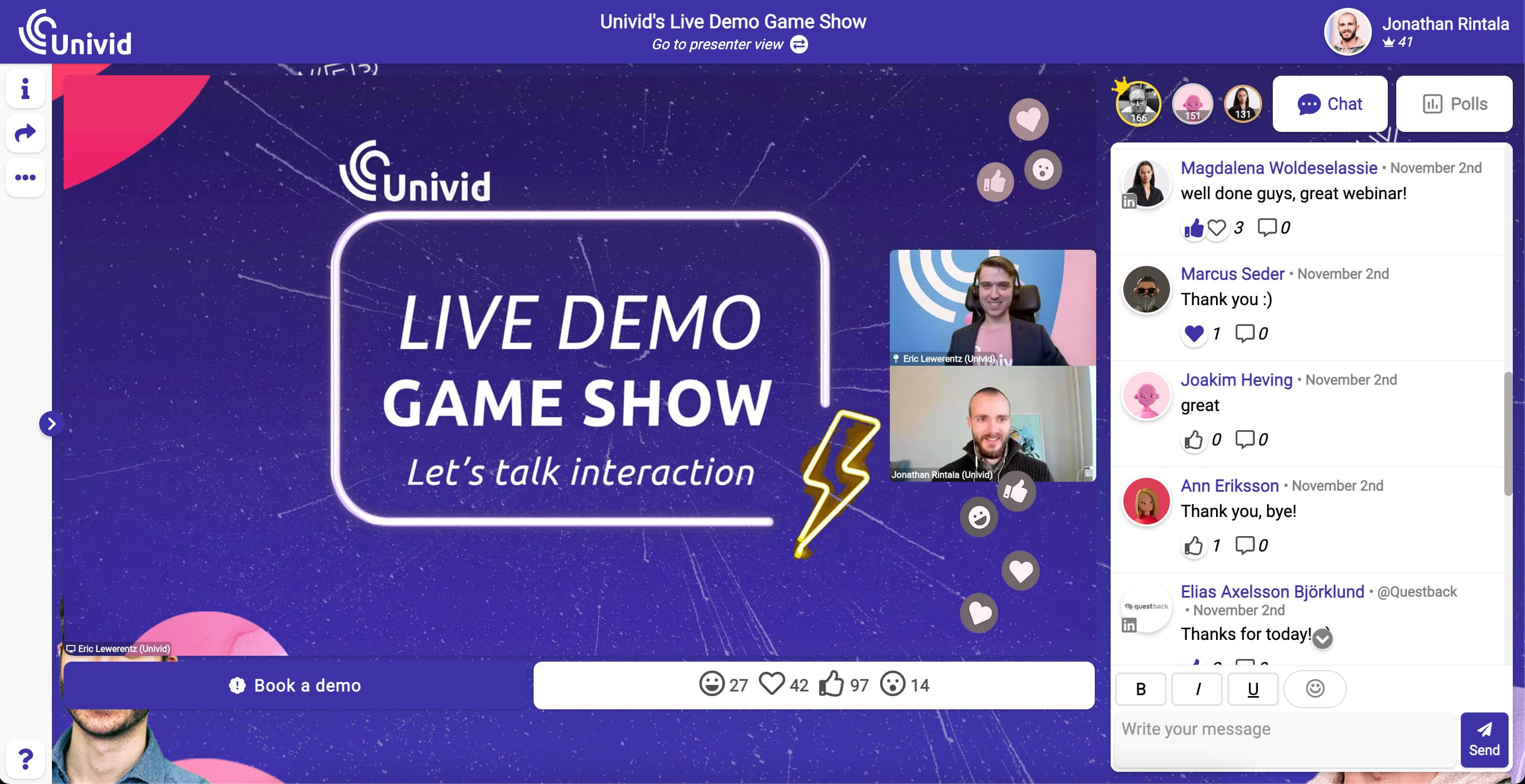
A live webinar session in Univid - interaction via chat, polls and live reactions
And don't forget to drive your next steps through the call-to-actions.
Here is a video explaining the top 5 CTA:s to use when creating your webinar (with examples)
Step 9: Analyze engagement and outcome
Depending on the tool you used, your webinar has now generated some very interesting data. Make sure you get a clear overview of the most important KPI:s to make sure you know what to improve and what went well.
Remember: It's better to consistently measure 2-3 KPI:s time over time, so you can improve, rather than trying to look at all details at once. Then you can improve and add more KPI:s as you go.
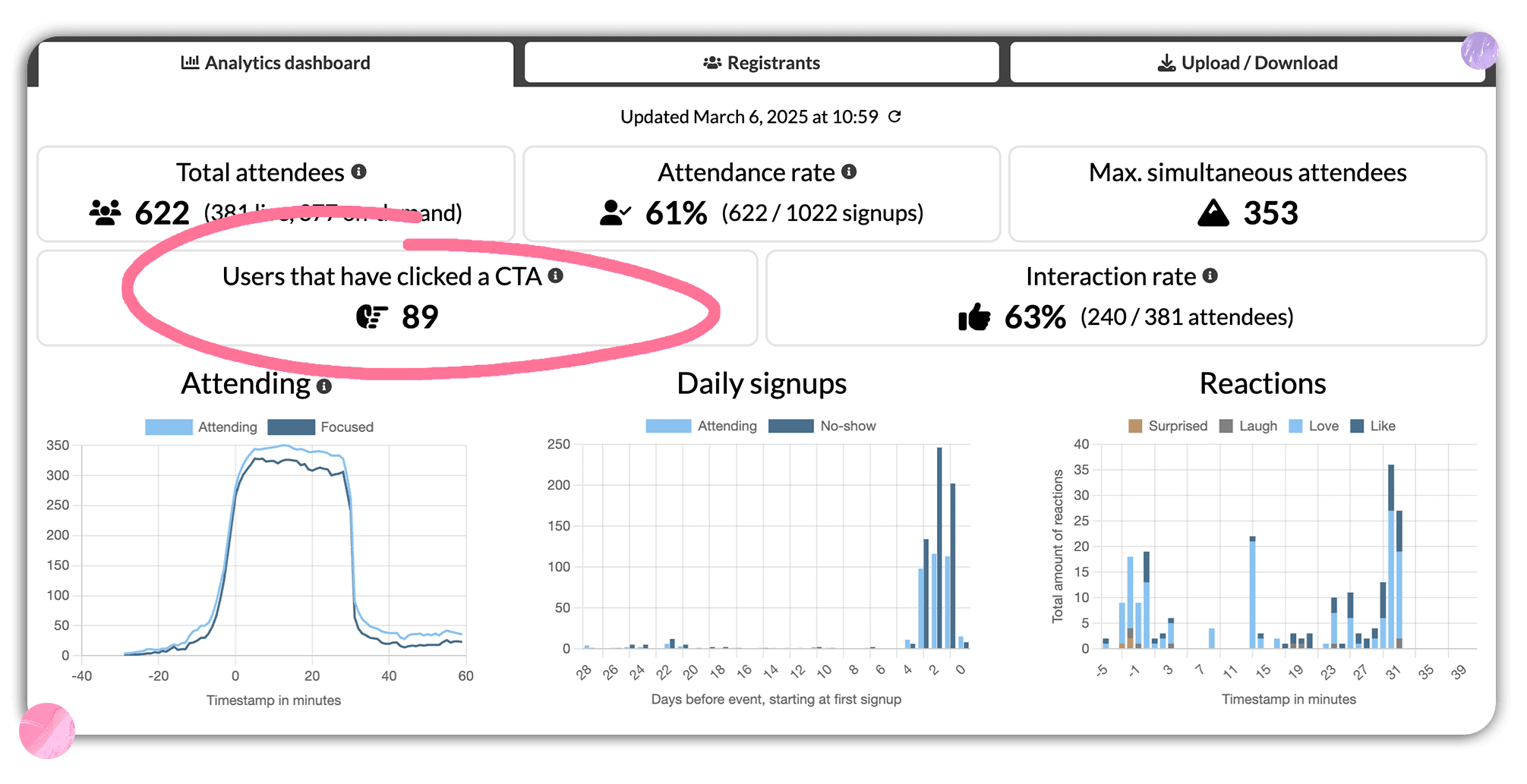
The analytics dashboard where you can follow up on your webinar KPI:s
Step 10: Follow-up and send out the on-demand recording
The live part of your webinar is now over! Great, it's now time to nurture the leads you have generated.
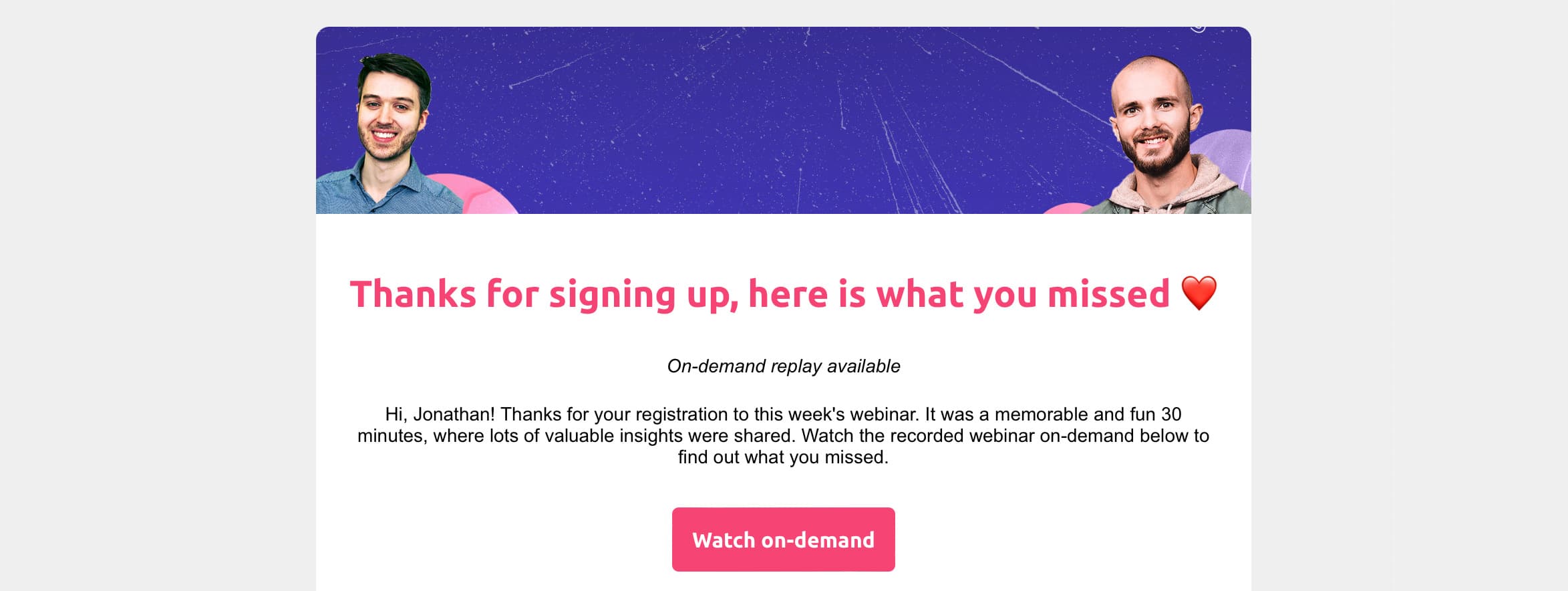
Follow-up email after a webinar
But before you jump into that. Don't forget to send out the recording of the webinar to the attendees as soon as possible. Preferably with a personal link to the webinar platform - so you can 1. get on-demand statistics and 2. a smooth experience for your no-shows.
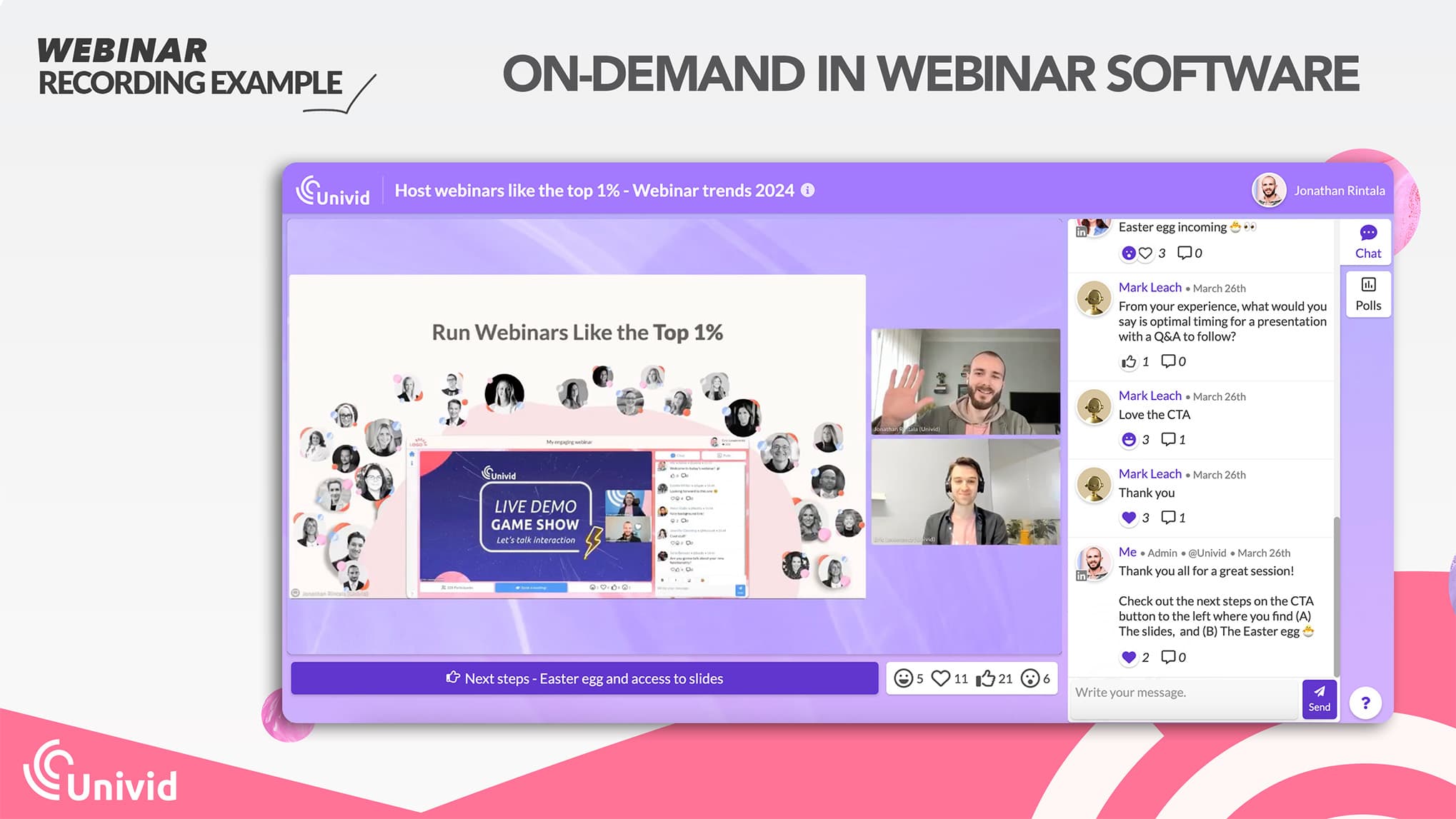
5 simple tips for hosting a successful webinar
Here are 5 simple and practical tips to help you host a successful webinar.
Start planning early – a common rookie mistake is to plan only a few days in advance and start marketing too close to the webinar. Make sure you have a couple of weeks and get the registration page up in time - so your participants can find out about the webinar and schedule it in their calendar.
Choose the right date and time - hosting a webinar when your participants are busy with other things is obviously not optimal. There are a number of days of the week and times you can choose from - to ensure as many people as possible show up. Here is our webinar planner that you can use to choose right and optimize the attendance rate.
Use a professional platform - using a customizable webinar tool can enhance the experience for participants and ensure you get more out of the work you put in. This includes offering more interaction opportunities for feedback, automating your work as a host, and facilitating the follow-up of statistics and participant lists. All things that can increase your conversion.
Create content for the participant - make sure your content is centered around delivering value to the participant - not just selling something. By creating value around a relevant question, customer case or case study - your webinar becomes relevant and you position yourself as an expert. Let the sales be an ending or a segment - where it is already obvious that you are someone to trust and want to do business with - then the pitch sells itself.
Plan the next step - a lot of people are busy handling scripts, guest speakers and marketing - and forget to plan the next step you want participants to take. By instead planning based on call-to-actions, e.g. "book meeting" or "download e-book", you can present these in a natural way during the webinar – without feeling forced or too salesy. See our guide with 5 great examples of CTAs you can copy.
7 reasons to host a webinar
Beyond driving sales and building exposure - there are many benefits to hosting webinars. Some key reasons for holding a webinar are that you create content that can last, position yourself as an expert in a field and get to know your potential customers better.
1. Positions yourself as an expert
Visibility is today absolutely crucial to success in the digital world. By hosting a webinar, you position yourself as an expert and take a leading role in the current niche.
With social selling and transparency being key in all slightly larger sales today, webinars are a great way to effectively position yourself as an actor to trust, knows the field and can answer complex questions in the domain.
A webinar enables you to establish a positive relationship with many leads at once. This is absolute key in B2B sales, where it is not just about a one-time interaction with the prospect, rather a long-term relationship.
By inviting your existing customers too, you can strengthen the relationship with them as well - reducing churn and increasing chances of upselling.
2. Showcase your value offer in a natural way
Through webinars, you can educate prospects or existing customers on your product or service. A perfect way to create a real and direct contact with customers where you emphasize the benefits, functions and how your value proposition solves the challenges the different customers face.
Let the webinar have a lot of interactivity - create dialogue and encourage participants to provide relevant input, questions and thoughts! This way you make sure people leave with relevant value and feel included.
Don't conduct a monologue or one-way communication! The risk is that you don't understand your ideal customer well enough and miss the current challenges and pains they are facing right now.
3. Create content that can live on
At the same time as you convey a live experience to all participants in the webinar, you create video material that can be used in many contexts in the future. For example, you can cut the material into a short summary to publish on social media or on the company blog.
A popular setup is to have the webinar available on-demand afterwards on your website or in the webinar platform, where interested individuals can sign up with an email address to access the webinar. A great way to continue sourcing leads and generating inbound!
4. Build brand awareness
Visibility is today absolutely crucial to success in the digital world. By hosting a webinar, you get your business out in many channels in a unique and engaging format.
A good webinar creates great value and a memorable experience for the participants who are thus happy to share this with colleagues and within their networks. Word of mouth is so powerful, because it helps you reach more people from your ICP, without you having to find them yourself - just deliver amazing value to a group of the right people and it will start to spread.
Also, by sharing the webinar in social media before, and repurposing the content afterwards - lots of people will see your brand and associate it with the topics you have spoken about.
5. Increasing conversions and revenue
A webinar can be used to the fullest to convert leads and generate revenue. By imparting knowledge and taking on the role of expert, potential customers will to a greater extent trust you and consider becoming your customer.
By having a clear call-to-action e.g. with a direct button to the homepage inside of your live webinar, you can drive direct conversions and next steps. Test our very own down below! 👇
Also, host a webinar - and sales will love you. Webinars are great ammunition to warm leads up that have gone cold or stalled - it's a perfect reason to reach out to a prospect and let them know you got value coming their way!
6. A cost-effective format for wider reach
A webinar that you host and produce yourself can be a resource efficient channel. A live event or larger product with studio is often more costly, as it places high demands on expected quality. However, it requires you find the processes and resources needed to host the webinar smoothly within your organization - preferably creating a blueprint that you can use over and over again, changing the topic, guest speakers, etc.
A webinar means that costly travel and physical events can be reduced - and you can instead budget on the parts of the sales process that make the biggest difference, such as marketing and making sure people will show up!
Webinars are also a perfect way to start exploring and reaching new geographies and markets in a cost effective way.
7. Get to know customers in new markets
With digital meetings and webinars, geographical location is no longer a limitation. Webinars can be an excellent way to start targeting and exploring new relevant markets, as you grow.
By offering an interactive experience, you can also gather a lot of relevant feedback about this new target market using polls and engagement. For example, you can find out what tools are they currently using, what pains are they having in relation to your area, and how your can offer value in their market.

Get to know a new target market by using interaction via for example polls - in this webinar segment it seems like Univid is a strong player 👀
In addition, it gives customers the opportunity to participate digitally on their terms, where they may previously have had time to set aside for a physical event. Finally, the planet will be happy with less traveling - webinars equal sustainability!
Frequently asked questions (FAQs)
Q: What is a webinar?
A webinar is a seminar or lecture in video format that is done online. Usually it is live streamed, but it can also be pre-recorded and broadcasted as if it were live. Typically, you work in a platform like Univid where you can interact with the participants via Q&A, live reactions, chat and polls.
Q: How does a webinar work?
In a webinar, the host uses a digital platform to present and educate an audience. Webinars are interactive events that invite engagement from the participants, who can help shape the content through questions and comments in a chat or Q&A session.
Q: What is the format of a webinar?
The format of a webinar is a live seminar that takes place online. It typically allows attendees to interact with the speakers in real-time, engaging via polls, chat or Q&A. Often webinars are one-to-many, and include a visual presentation and audio. The webinar format can be used for a variety of purposes such as education, lead generation, product demos, and sales pitches.
Q: How do I create a free webinar?
The easiest way to create a webinar for free is with a popular live-streaming platform like Youtube, Facebook Live, or Univid. Typically, with a webinar platform offering a freemium plan, you can start for free, host with a limited participant count, and then scale things as you grow. Think about what engagement features you need and the type of experience you want to create.
Q: What is the best tool for webinars?
Univid is considered a top pick amongst the best webinar tools. This platform offers a features such as branded registrations, call-to-action buttons, and the ability to engage the audience in live reactions, Q&A and polls. Some other alternatives are meeting software such as Meet, or Teams, or open live streaming platforms such as Youtube. Try them out and choose the one that best suits your needs.
Q: How do you set up a webinar?
To set up a webinar, you first need to choose a webinar tool, create a plan for content targeting your audience, set a time, invite guest speakers, and promote it. Then prepare for interactivity, make sure you have a good internet connection, and that you achieve your desired next step.
